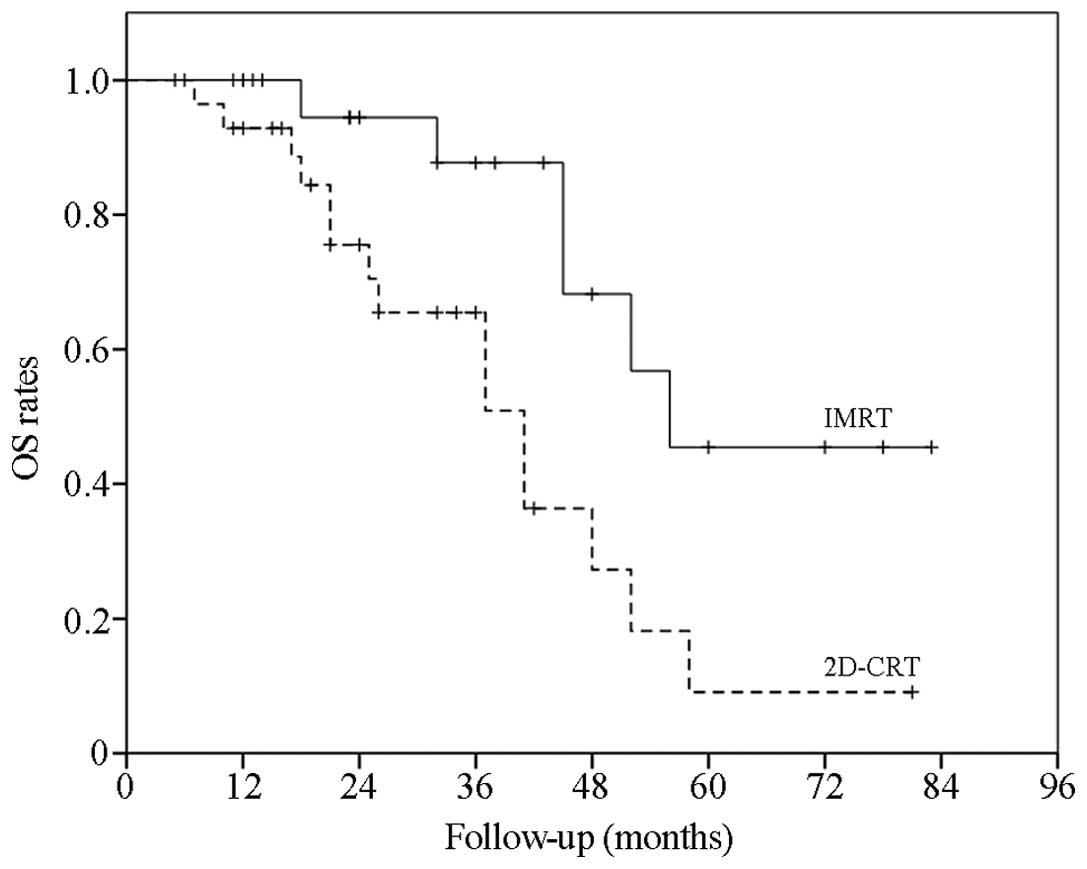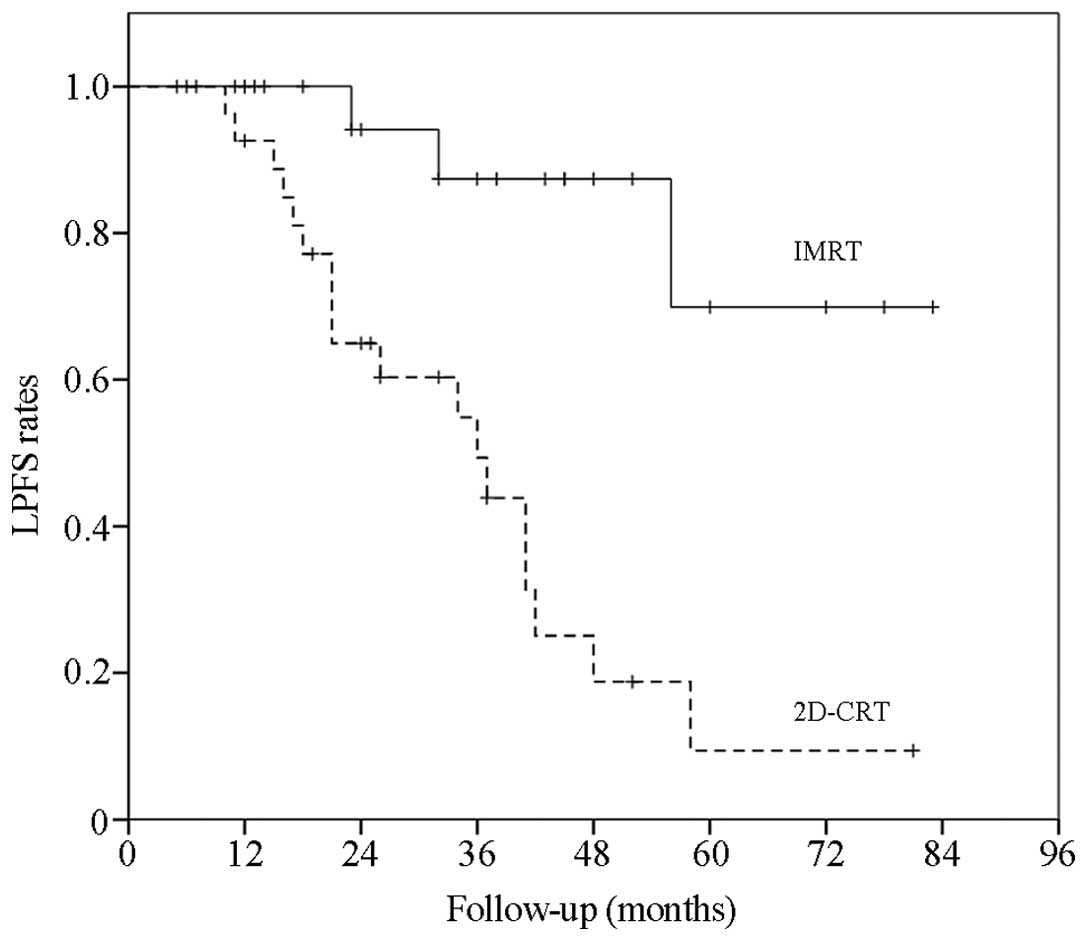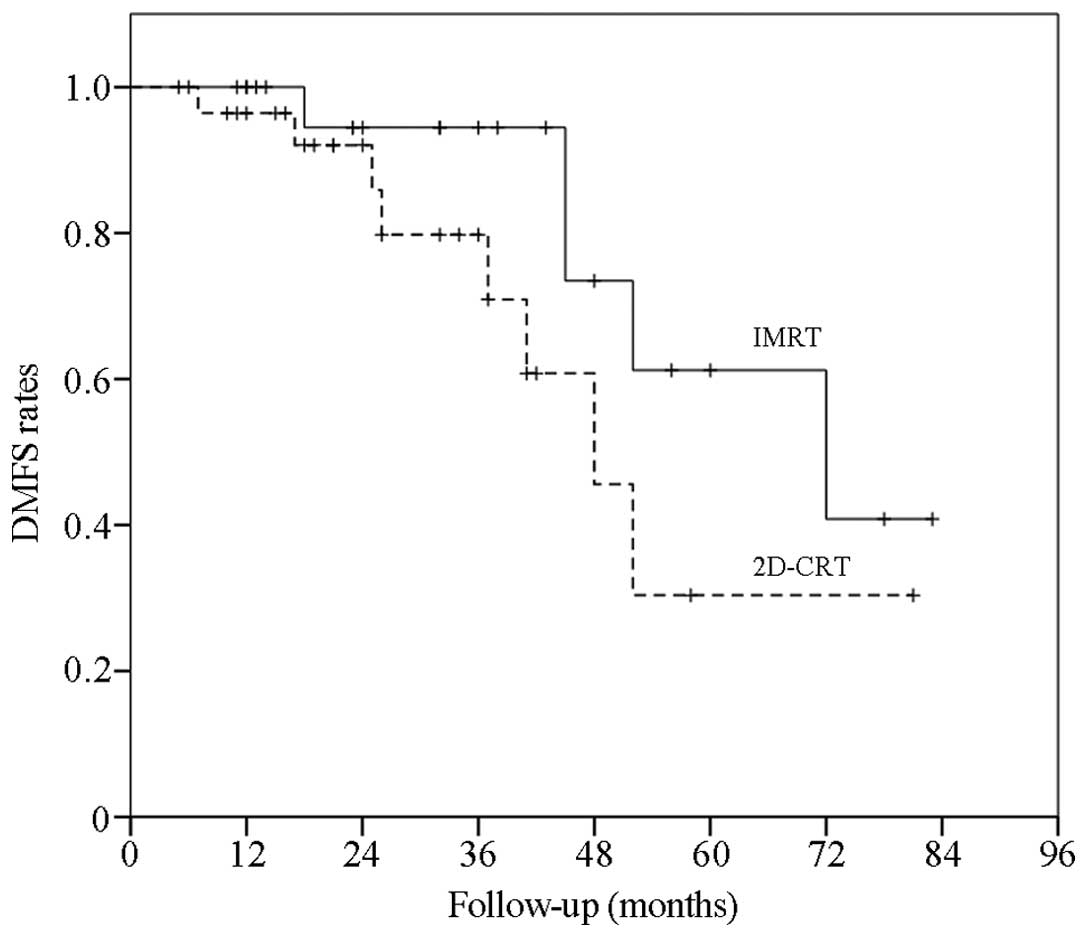|
1
|
Liu Q, Chen JO, Huang QH and Li YH: Trends
in the survival of patients with nasopharyngeal carcinoma between
1976 and 2005 in Sihui, China: A population-based study. Chin J
Cancer. 32:325–333. 2013. View Article : Google Scholar : PubMed/NCBI
|
|
2
|
Sun Y, Tang LL, Chen L, Li WF, Mao YP, Liu
LZ, Lin AH, Li L and Ma J: Promising treatment outcomes of
intensity-modulated radiation therapy for nasopharyngeal carcinoma
patients with N0 disease according to the seventh edition of the
AJCC staging system. BMC Cancer. 12:682012. View Article : Google Scholar : PubMed/NCBI
|
|
3
|
Peng G, Wang T, Yang KY, Zhang S, Zhang T,
Li Q, Han J and Wu G: A prospective, randomized study comparing
outcomes and toxicities of intensity-modulated radiotherapy vs.
conventional two-dimensional radiotherapy for the treatment of
nasopharyngeal carcinoma. Radiother Oncol. 104:286–293. 2012.
View Article : Google Scholar : PubMed/NCBI
|
|
4
|
Lee CC, Chu ST, Chou P, Lee CC and Chen
LF: The prognostic influence of prevertebral space involvement in
nasopharyngeal carcinoma. Clin Otolaryngol. 33:442–449. 2008.
View Article : Google Scholar : PubMed/NCBI
|
|
5
|
Razek A Abdel Khalek Abdel and King A: MRI
and CT of nasopharyngeal carcinoma. AJR Am J Roentgenol. 198:11–18.
2012. View Article : Google Scholar : PubMed/NCBI
|
|
6
|
Poon PY, Tsang VH and Munk PL: Tumour
extent and T stage of nasopharyngeal carcinoma: A comparison of
magnetic resonance imaging and computed tomographic findings. Can
Assoc Radiol J. 51:287–295. 2000.PubMed/NCBI
|
|
7
|
Zhang SX, Han PH, Zhang GQ, Wang RH, Ge
YB, Ren ZG, Li JS and Fu WH: Comparison of SPECT/CT, MRI and CT in
diagnosis of skull base bone invasion innasopharyngeal carcinoma.
Biomed Mater Eng. 24:1117–1124. 2014.PubMed/NCBI
|
|
8
|
Edge S, Fritz AG, Byrd DR, Greene FL and
Compton CC: Pharynx (including base of tongue, soft palate and
uvula). AJCC Cancer Staging Manual. Edge S, Bryd DR, Compton CC,
Fritz AG, Greene FL and Trotti A: (7th). Springer. (New York, NY).
41–56. 2010.
|
|
9
|
World Medical Association: World Medical
Association Declaration of Helsinki: Ethical principles for medical
research involving human subjects. JAMA. 310:2191–2194. 2013.
View Article : Google Scholar : PubMed/NCBI
|
|
10
|
Purdy JA: Current ICRU definitions of
volumes: Limitations and future directions. Semin Radiat Oncol.
14:27–40. 2004. View Article : Google Scholar : PubMed/NCBI
|
|
11
|
Zong JF, Lin SJ, Zhang Z, Chen YB, Quo QJ
and Pan JJ: Comparative study of nasopharyngeal carcinoma staging
system between the Chinese 2008 and 1992 Fuzhou. Chin J Radiat
Oncol. 19:481–485. 2010.
|
|
12
|
Chen L, Liu LZ, Chen M, Li WF, Yin WJ, Lin
AH, Sun Y, Li L and Ma J: Prognostic value of subclassification
using MRI in the t4 classification nasopharyngeal carcinoma
intensity-modulated radiotherapy treatment. Int J Radiat Oncol Biol
Phys. 84:196–202. 2012. View Article : Google Scholar : PubMed/NCBI
|
|
13
|
Cao CN, Luo JW, Gao L, Yi JL, Huang XD,
Wang K, Zhang SP, Qu Y, Li SY, Cai WM, et al: Clinical outcomes and
patterns of failure after intensity-modulated radiotherapy for T4
nasopharyngeal carcinoma. Oral Oncol. 49:175–181. 2013. View Article : Google Scholar : PubMed/NCBI
|
|
14
|
Liu MT, Hsieh CY, Chang TH, Lin JP, Huang
CC and Wang AY: Prognostic factors affecting the outcome of
nasopharyngeal carcinoma. Jpn J Clin Oncol. 33:501–508. 2003.
View Article : Google Scholar : PubMed/NCBI
|
|
15
|
Chen CY, Han F, Zhao C, Lu LX, Sun Y, Liu
XF and Lu TX: Treatment results and late complications of 556
patients with locally advanced nasopharyngeal carcinoma treated
with radiotherapy alone. Br J Radiol. 82:452–458. 2009. View Article : Google Scholar : PubMed/NCBI
|
|
16
|
Feng AC, Wu MC, Tsai SY, Chan KY, Cheng
SH, Wang A, Chen SS, Jian JJ, Terng SD and Huang AT: Prevertebral
muscle involvement in nasopharyngeal carcinoma. Int J Radiat Oncol
Biol Phys. 65:1026–1035. 2006. View Article : Google Scholar : PubMed/NCBI
|
|
17
|
Zhou GQ, Mao YP, Chen L, Li WF, Liu LZ,
Sun Y, Chen Y, Tian L, Lin AH, Li L, et al: Prognostic value of
prevertebral space involvement in nasopharyngeal carcinoma based on
intensity-modulated radiotherapy. Int J Radiat Oncol Biol Phys.
82:1090–1097. 2012. View Article : Google Scholar : PubMed/NCBI
|
|
18
|
Leung SW and Lee TF: Treatment of
nasopharyngeal carcinoma by tomotherapy: Five-year experience.
Radiat Oncol. 8:1072013. View Article : Google Scholar : PubMed/NCBI
|
|
19
|
Lai SZ, Li WF, Chen L, Luo W, Chen YY, Liu
LZ, Sun Y, Lin AH, Liu MZ and Ma J: How does intensity-modulated
radiotherapy versus conventional two-dimensional radiotherapy
influence the treatment results in nasopharyngeal carcinoma
patients? Int J Radiat Oncol Biol Phys. 80:661–668. 2011.
View Article : Google Scholar : PubMed/NCBI
|
|
20
|
Han F, Zhao C, Huang SM, Lu LX, Huang Y,
Deng XW, Mai WY, Teh BS, Butler EB and Lu TX: Long-term outcomes
and prognostic factors of re-irradiation for locally recurrent
nasopharyngeal carcinoma using intensity-modulated radiotherapy.
Clin Oncol (R Coll Radiol). 24:569–576. 2012. View Article : Google Scholar : PubMed/NCBI
|
|
21
|
Siala W, Mnejja W, Khabir A, Ben Mahfoudh
K, Boudawara T, Ghorbel A, Frikha M and Daoud J: Late neurotoxicity
after nasopharyngeal carcinoma treatment. Cancer Radiother.
13:709–714. 2009. View Article : Google Scholar : PubMed/NCBI
|
|
22
|
Lee AW, Law SC, Ng SH, Chan DK, Poon YF,
Foo W, Tung SY, Cheung FK and Ho JH: Retrospective analysis of
nasopharyngeal carcinoma treated during 1976–1985: Late
complications following megavoltage irradiation. Br J Radiol.
65:918–928. 1992. View Article : Google Scholar : PubMed/NCBI
|
|
23
|
Teo PM, Leung SF, Chan AT, Leung TW, Choi
PH, Kwan WH, Lee WY, Chau RM, Yu PK and Johnson PJ: Final report of
a randomized trial on altered-fractionated radiotherapy in
nasopharyngeal carcinoma prematurely terminated by significant
increase in neurologic complications. Int J Radiat Oncol Biol Phys.
48:1311–1322. 2000. View Article : Google Scholar : PubMed/NCBI
|
|
24
|
Hua YJ, Han F, Lu LX, Mai HQ, Guo X, Hong
MH, Lu TX and Zhao C: Long-term treatment outcome of recurrent
nasopharyngeal carcinoma treated with salvage intensity modulated
radiotherapy. Eur J Cancer. 48:3422–3428. 2012. View Article : Google Scholar : PubMed/NCBI
|

















